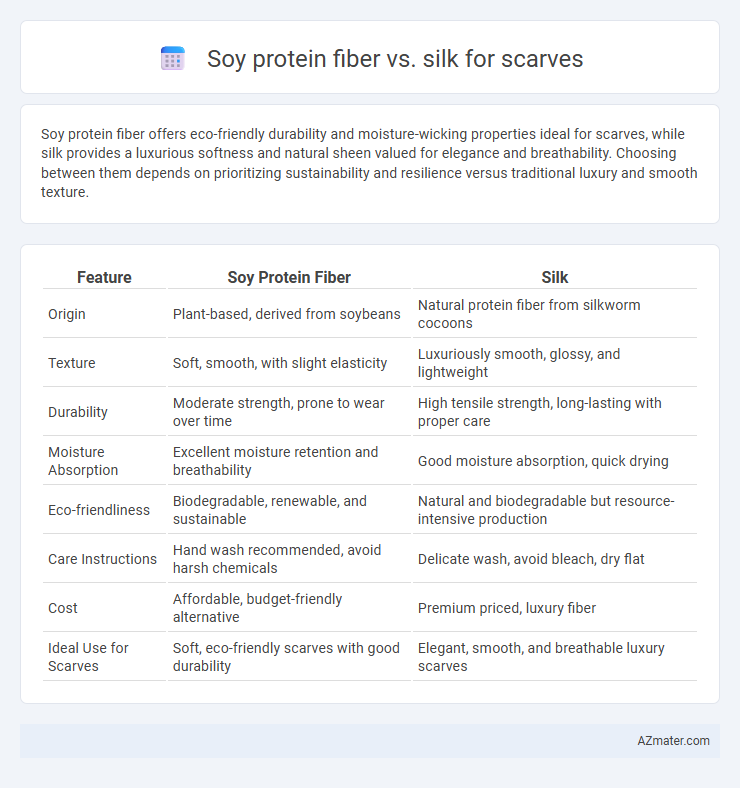Soy protein fiber offers eco-friendly durability and moisture-wicking properties ideal for scarves, while silk provides a luxurious softness and natural sheen valued for elegance and breathability. Choosing between them depends on prioritizing sustainability and resilience versus traditional luxury and smooth texture.
Table of Comparison
| Feature | Soy Protein Fiber | Silk |
|---|---|---|
| Origin | Plant-based, derived from soybeans | Natural protein fiber from silkworm cocoons |
| Texture | Soft, smooth, with slight elasticity | Luxuriously smooth, glossy, and lightweight |
| Durability | Moderate strength, prone to wear over time | High tensile strength, long-lasting with proper care |
| Moisture Absorption | Excellent moisture retention and breathability | Good moisture absorption, quick drying |
| Eco-friendliness | Biodegradable, renewable, and sustainable | Natural and biodegradable but resource-intensive production |
| Care Instructions | Hand wash recommended, avoid harsh chemicals | Delicate wash, avoid bleach, dry flat |
| Cost | Affordable, budget-friendly alternative | Premium priced, luxury fiber |
| Ideal Use for Scarves | Soft, eco-friendly scarves with good durability | Elegant, smooth, and breathable luxury scarves |
Introduction to Soy Protein Fiber and Silk
Soy protein fiber, a sustainable textile derived from soybean protein, offers a soft, lightweight, and breathable alternative to traditional fibers. Silk, produced by silkworms, is renowned for its luxurious texture, natural sheen, and strength, making it a premium choice for scarves. Both fibers provide excellent draping qualities, but soy protein fiber excels in moisture absorption and eco-friendliness compared to silk's delicate care requirements.
Origins and Production Processes
Soy protein fiber originates from defatted soy flour, a byproduct of soybean oil extraction, processed through a wet spinning method to create a soft, breathable textile. Silk is produced from the cocoons of the Bombyx mori silkworm through a labor-intensive reeling process involving boiling and unwinding the silk threads. Both fibers offer sustainable qualities, with soy protein fiber deriving from agricultural waste and silk depending on sericulture with renewable natural resources.
Environmental Impact Comparison
Soy protein fiber, derived from renewable soybean byproducts, offers a biodegradable and low-carbon alternative to traditional silk, which involves resource-intensive sericulture and impacts mulberry cultivation. Soy protein fiber production consumes less water and emits fewer greenhouse gases compared to silk's energy-demanding processes, making it more sustainable in terms of ecological footprint. Both fibers are biodegradable, but soy protein fiber's utilization of agricultural waste promotes circular economy principles, reducing environmental strain compared to silk production's dependence on silkworm farming and cocoon processing.
Texture and Feel: Aesthetic Differences
Soy protein fiber scarves exhibit a smooth, silky texture with a subtle sheen, offering a soft, lightweight feel that drapes elegantly. Silk scarves provide a natural lustrous finish that feels cool and luxurious against the skin, with a slightly more vibrant luster and fluidity. The soy protein fiber tends to have a matte softness and gentle warmth, while silk excels in crispness and a sleek, polished aesthetic.
Durability and Longevity
Soy protein fiber scarves offer moderate durability due to their semi-synthetic composition, providing a soft texture while maintaining reasonable resistance to wear and tear over time. Silk scarves excel in longevity with natural protein fibers known for their exceptional strength and resilience, retaining vibrant colors and fabric integrity even after extended use. The inherent tensile strength of silk ensures superior durability compared to soy protein fiber, making it a preferred choice for long-lasting scarves.
Breathability and Comfort
Soy protein fiber offers excellent breathability and moisture-wicking properties, making it ideal for scarves worn in warmer climates. Its natural softness provides superior comfort against the skin compared to synthetic fibers. Silk also excels in breathability and temperature regulation but may feel smoother and cooler, giving a luxurious sensation while maintaining lightweight comfort.
Hypoallergenic Properties
Soy protein fiber is highly valued for its hypoallergenic properties, making it an excellent choice for sensitive skin as it resists bacterial growth and irritants. Silk, while naturally hypoallergenic due to its smooth protein structure and moisture-wicking abilities, can sometimes cause allergic reactions in individuals sensitive to sericin, a silk-specific protein. Both fibers offer skin-friendly benefits, but soy protein fiber tends to be preferred for those requiring enhanced hypoallergenic protection in scarves.
Color Retention and Dyeing Capabilities
Soy protein fiber exhibits superior dye absorption and vibrant color retention compared to silk, maintaining rich hues even after multiple washes. Silk offers a natural sheen and smooth texture but tends to fade faster under prolonged exposure to sunlight and frequent laundering. Advanced dyeing techniques enhance soy protein fiber's colorfastness, making it a durable, eco-friendly choice for scarves.
Cost and Accessibility
Soy protein fiber scarves offer a cost-effective alternative to silk, with prices generally lower due to the more affordable raw materials and simpler production methods. Silk scarves tend to be pricier and less accessible, as silk cultivation requires labor-intensive sericulture and specific climatic conditions. The widespread availability of soy protein fibers makes soy scarves easier to source, appealing to budget-conscious consumers seeking sustainable options.
Which is Best for Scarves?
Soy protein fiber offers a soft, hypoallergenic, and breathable texture ideal for sensitive skin, making it excellent for lightweight scarves with a natural sheen. Silk provides luxurious smoothness, superior strength, and excellent moisture-wicking properties, lending itself to elegant, durable scarves with a rich luster. For scarves, silk remains the best choice when prioritizing classic elegance and durability, while soy protein fiber suits those seeking eco-friendly, gentle alternatives.

Infographic: Soy protein fiber vs Silk for Scarf
 azmater.com
azmater.com